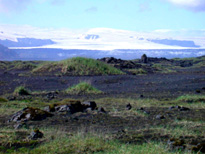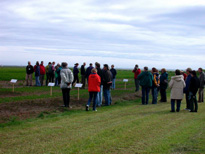



Back
| Iceland—The land of fire and ice |
||
 |
 |
|
| Gull Foss, a very large waterfall that is fed by glaciers. |
Lava from Mt. Hekla, which has had many very large eruptions. |
|
 |
 |
|
| Reclaimed sand deserts with glacier in the background. Sand deserts form when volcanoes thrust through glaciers to spawn massive mudflows. Here, Leymus has been used to stabalize the site. | Here, scientists inspect field trips using varieties of lupines. The Alaskan species (L. nooktkatensis) has been used throughout Iceland to stabalize deserts and erosion sites. |
|
| Over 1100 years of deforestation and farming have left this fascinating island bereft of forest and plagued by enormous erosion problems. Most of the landscape has been formed by volcanism. Recent lavas are common, but the greatest challenge facing reclamation scientists in Iceland is to stabilize the sand deserts. To this end, extensive reclamation projects, featuring Lupinus nootkatensis, have been undertaken since the mid-1970s. I attended the 10th International Lupin Conference in June, 2002, and was able to explore a wide variety of reclamation sites. | ||
Back |
||